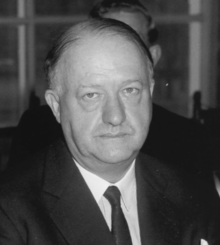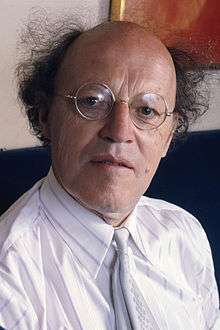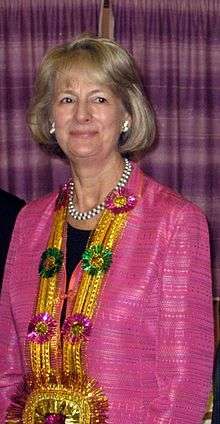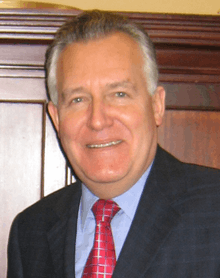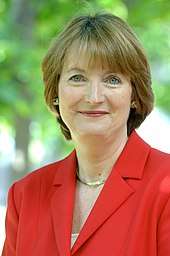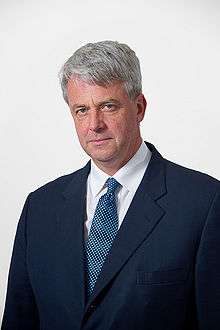Lord Privy Seal
| Lord Keeper of the Privy Seal | |
|---|---|
|
Royal Arms as used by Her Majesty's Government | |
| Style | The Right Honourable |
| Appointer |
Monarch of the United Kingdom on advice of the Prime Minister |
| Inaugural holder | William Melton |
| Formation | 1307 |
.svg.png) |
| This article is part of a series on the politics and government of the United Kingdom |
|
|
|
|
|
The Lord Privy Seal (or, more formally, the Lord Keeper of the Privy Seal) is the fifth of the Great Officers of State in the United Kingdom, ranking beneath the Lord President of the Council and above the Lord Great Chamberlain. Originally, its holder was responsible for the monarch's personal (privy) seal (as opposed to the Great Seal of the Realm, which is in the care of the Lord Chancellor) until the use of such a seal became obsolete. The office is currently one of the traditional sinecure offices of state. Today, the holder of the office is invariably given a seat in the Cabinet of the United Kingdom.
Though one of the oldest offices in government anywhere, it has no particular function today because the use of a privy seal has been obsolete for centuries; thus the office has generally been used as a kind of Minister without Portfolio. Since the premiership of Clement Attlee, the position of Lord Privy Seal has frequently been combined with that of Leader of the House of Lords or Leader of the House of Commons. The office of Lord Privy Seal, unlike those of Leader of the Lords or Commons, is eligible for a ministerial salary under the Ministerial and other Salaries Act 1975.[1] The office does not confer membership of the House of Lords, leading to Ernest Bevin's remark on holding this office that he was "neither a Lord, nor a Privy, nor a Seal".[2]
During the reign of Edward I, prior to 1307, the Privy Seal was kept by the Controller of the Wardrobe.[3] The Lord Privy Seal was the president of the Court of Requests during its existence.
English Lords Privy Seal, 1307–1707
14th century
- William Melton (1307–1312)
- Roger Northburgh (1312–1316)
- Thomas Charlton (1316–1320) (Archdeacon of Northumberland)
- Robert Baldock (1320–1323)
- Robert Wodehouse (1323)
- Robert Ayleston (1323–1324)
- William Ayermin (1324–1325)
- Henry Cliff (1325)
- William Herlaston (1325–1326)
- Robert Wyvil (1326–1327)
- Richard Airmyn (1327–1328)
- Adam Lymbergh (1328–1329) (Chancellor of Ireland)
- Richard Bury, (1329–1334) (Bishop of Durham from 1333)
- Robert Ayleston (1334)
- Robert Tawton (1334–1335) (Archdeacon of Durham)
- William de la Zouch (1335–1337)
- Richard Bintworth,(1337–1338) (Bishop of London)
- William Kilsby (1338–1342) (Treasurer of the Chamber)
- John de Ufford, 1342–1344) (Dean of Lincoln then Archbishop of Canterbury)
- Thomas Hatfield, (1344–1345) Bishop of Durham
- John Thoresby, (1345–1347) (Bishop of St Davids and Archbishop of York)
- Simon Islip, (1347–1350) (Archbishop of Canterbury)
- Michael Northburgh (1350–1354) (Archdeacon of Suffolk)
- Thomas Bramber (1354–1355) (Treasurer of the Chamber)
- John Winwick (1355–1360)
- John Buckingham, (1360–1363) Dean of Lichfield and Bishop of Lincoln)
- William of Wykeham (1363–1367) (Treasurer of the Chamber and Archdeacon of Lincoln)
- Peter Lacy (1367–1371)
- Nicholas Carew (1371–1377)
- John Fordham (1377–1381) (Dean of Wells then Bishop of Durham)
- William Dighton (1381–1382)
- Walter Skirclaw, (1382–1386) (Bishop of Coventry and Lichfield)
- John Waltham, (1386–1389) (Bishop of Salisbury)
- Edmund Stafford, (1389–1396) (Bishop of Exeter)
- Guy Mone (1396–1397) (Bishop of St Davids)
- Richard Clifford (1397–1401) (Keeper of the Great Wardrobe, later Bishop of London)
15th century
- Thomas Langley, (1401–1405) (Dean of York)
- Nicholas Bubwith, (1405–1406) (Archdeacon of Dorset then Bishop of London)
- John Prophet, (1406–1415) (Dean of York)
- John Wakering, (1415–1416) (Archdeacon of Canterbury then Bishop of Norwich)
- Henry Ware, (1416–1418) (Bishop of Chichester)
- John Kemp, (1418–1421) (Archdeacon of Durham then Bishop of Rochester)
- John Stafford, (1421–1422) (Dean of St Martins le Grand)
- William Alnwick, (1422–1432) (Archdeacon of Salisbury then Bishop of Norwich)
- William Lyndwood, (1432–1443) (Archdeacon of Oxford then Bishop of St David's)
- Thomas Beckington, (1443–1444) (Bishop of Bath and Wells)
- Adam Moleyns, (1444–1450) (Dean of Salisbury then Bishop of Chichester)
- Andrew Holes, (1450–1452) (Archdeacon of York)
- Thomas Lisieux, (1452–1456) (Dean of St Paul's)
- Laurence Booth, (1456–1460) (Dean of St Paul's then Bishop of Durham)
- Robert Stillington, (1460–1467) (Archdeacon of Taunton then Bishop of Bath and Wells)
- Thomas Rotheram, (1467–1470) (Bishop of Rochester)
- John Hales, (1470–1471) (Bishop of Coventry and Lichfield)
- Thomas Rotheram, (1471–1474) (Bishop of Rochester)
- John Russell, (1474–1483) (Bishop of Rochester, later Bishop of Lincoln)
- John Gunthorpe, (1483–1485) (Dean of the Chapel Royal and Dean of Wells)
- Peter Courtenay, (1485–1487) (Bishop of Exeter)
- Richard Foxe, (1487–1516) (Bishop of Exeter, later Bishop of Bath and Wells, Bishop of Durham and Bishop of Winchester)
16th century
- Thomas Ruthall, (1516–1523) (Bishop of Durham)
- Henry Marney, 1st Baron Marney (1523)
- Cuthbert Tunstall, (1523–1530) (Bishop of London)
- Thomas Boleyn, 1st Earl of Wiltshire (1530–1536)
- Thomas Cromwell, 1st Earl of Essex (1536–1540)
- William FitzWilliam, 1st Earl of Southampton (1540–1542)
- John Russell, 1st Earl of Bedford (1542–1555)
- William Paget, 1st Baron Paget (1555–1558)
- Nicholas Bacon (1558–1571)
- William Cecil, 1st Baron Burghley (1571–1572)
- William Howard, 1st Baron Howard of Effingham (1572–1573)
- Thomas Smith (1573–1576)
- Francis Walsingham (1576–1590)
- William Cecil, 1st Baron Burghley (1590–1598)
- Robert Cecil, 1st Earl of Salisbury (1598–1608)
17th century
- Henry Howard, 1st Earl of Northampton (1608–1614)
- Robert Carr, 1st Earl of Somerset (1614–1616)
- Edward Somerset, 4th Earl of Worcester (1616–1625)
- John Coke (1625–1628)
- Robert Naunton (1628)
- Henry Montagu, 1st Earl of Manchester (1628–1642)
- Lucius Cary, 2nd Viscount Falkland (1643)
- Edward Nicholas (1643–1644)
- Henry Bourchier, 5th Earl of Bath (1644–1654)
- John Robartes, 2nd Baron Robartes (1661–1673)
- Commissioners during Robartes' absence as Lord Lieutenant of Ireland, 1669
- Edward Dering, 2nd Baronet
- Thomas Strickland
- Robert Milward
- Arthur Annesley, 1st Earl of Anglesey (1673–1682)
- George Savile, 1st Marquess of Halifax (1682–1685)
- Henry Hyde, 2nd Earl of Clarendon (1685–1687)
- Commissioners during Clarendon's absence in Ireland, 1685
- Thomas Livingston, 1st Viscount Teviot
- Robert Phillips
- John Evelyn
- Henry Arundell, 3rd Baron Arundell of Wardour (1687–1688)
- George Savile, 1st Marquess of Halifax (1689–1690)
- Commissioners 1690–1692
- William Cheney
- John Knatchbull, 2nd Baronet
- William Pulteney
- Thomas Herbert, 8th Earl of Pembroke (1692–1699)
- Commissioners during Pembroke's absence as Lord Lieutenant of Ireland, 1697
- John Lowther, 1st Viscount Lonsdale (1699–1700)
18th century
- Ford Grey, 1st Earl of Tankerville (1700–1701)
- Commissioners 1701–1702
- Edward Southwell
- Christopher Musgrave
- James Vernon
- John Sheffield, 1st Duke of Buckingham and Normanby (1702–1705)
- John Holles, 1st Duke of Newcastle (1705–1707)
British Lords Privy Seal, 1707–present
18th century
- John Holles, 1st Duke of Newcastle (1707–1711)
- John Robinson, Bishop of Bristol (1711–1713)
- Commissioners during Robinson's absence at the Treaty of Utrecht, 1711
- George Beaumont, 4th Baronet
- Robert Byerley
- Edward Nicholas
- William Legge, 1st Earl of Dartmouth (1713–1714)
- Thomas Wharton, 1st Marquess of Wharton (1714–1715)
- Commissioners 1715
- Edward Southwell
- Christopher Musgrave, 5th Baronet
- Andrew Charleton
- Charles Spencer, 3rd Earl of Sunderland (1715–1716)
- Commissioners during Sunderland's absence at Aix-la-Chapelle, 1716[4]
- Edward Southwell
- James Vernon[5] or James Vernon[6]
- Andrew Charleton
- Evelyn Pierrepont, 1st Duke of Kingston-upon-Hull (1716–1718)
- Henry Grey, 1st Duke of Kent (1718–1719)
- Evelyn Pierrepont, 1st Duke of Kingston-upon-Hull (1720–1726)
- Thomas Trevor, 1st Baron Trevor (1726–1730)
- Spencer Compton, 1st Earl of Wilmington (1730–1731)
- In Commission 1731
- William Cavendish, 3rd Duke of Devonshire (1731–1733)
- Henry Lowther, 3rd Viscount Lonsdale (1733–1735)
- Francis Godolphin, 2nd Earl of Godolphin (1735–1740)
- John Hervey, 2nd Baron Hervey (1740–1742)
- John Leveson-Gower, 2nd Baron Gower (1742–1743)
- George Cholmondeley, 3rd Earl of Cholmondeley (1743–1744)
- John Leveson-Gower, 1st Earl Gower, 2nd Baron Gower (1744–1755)
- Charles Spencer, 3rd Duke of Marlborough (1755)
- Granville Leveson-Gower, 2nd Earl Gower (1755–1757)
- Richard Grenville-Temple, 2nd Earl Temple (1757–1761)
- In Commission 1761
- John Russell, 4th Duke of Bedford (1761–1763)
- George Spencer, 4th Duke of Marlborough (1763–1765)
- Thomas Pelham-Holles, 1st Duke of Newcastle (1765–1766)
- William Pitt, 1st Earl of Chatham (1766–1768)
- Commissioners 1768
- Richard Sutton
- William Blair
- William Fraser
- William Pitt, 1st Earl of Chatham (1768)
- George Hervey, 2nd Earl of Bristol (1768–1770)
- George Montagu-Dunk, 2nd Earl of Halifax (1770–1771)
- Henry Howard, 12th Earl of Suffolk (1771)
- Augustus FitzRoy, 3rd Duke of Grafton (1771–1775)
- William Legge, 2nd Earl of Dartmouth (1775–1782)
- Augustus FitzRoy, 3rd Duke of Grafton (1782–1783)
- Frederick Howard, 5th Earl of Carlisle (1783)
- Charles Manners, 4th Duke of Rutland (1783–1784)
- Commissioners 1784
- William Fraser
- Stephen Cotterell
- Evan Nepean
- Granville Leveson-Gower, 1st Marquess of Stafford (1784–1794)
- George Spencer, 2nd Earl Spencer (1794)
- John Pitt, 2nd Earl of Chatham (1794–1798)
- John Fane, 10th Earl of Westmorland (1798-1806)
Other countries
- Keeper of the seals of France
- Lord Keeper of the Privy Seal of Japan
- Keeper of the Rulers' Seal of Malaysia
See also
- Keeper of the seals
- Keeper of the Privy Seal of Scotland
- Lord Keeper of the Great Seal
- Lord Privy Seal (term)
References
- ↑ http://www.legislation.gov.uk/ukpga/1975/27
- ↑ Beckett, Francis (1997). Clem Attlee: A Biography. London: Richard Cohen. p. 285. ISBN 9781860661013.
- ↑ Sayers, Jane. "The English Royal Chancery" (PDF). Retrieved 3 January 2012.
- ↑ "No. 5463". The London Gazette. 25–28 August 1716. p. 1.
- ↑ VERNON, James II (1677–1756), of Westminster, Mdx. at The History of Parliament Online. Accessed 14 June 2014.
- ↑ VERNON, James (1646–1727), of Frith Street, Westminster. at The History of Parliament Online. Accessed 14 June 2014.
- Sergeant, John (2002). Give me ten seconds. Pan Books. ISBN 0-330-48490-7.
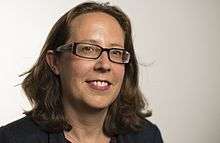

.jpg)
_after_George_Romney_of_John_Fane%2C_10th_Earl_of_Westmorland%2C_1796.jpg)






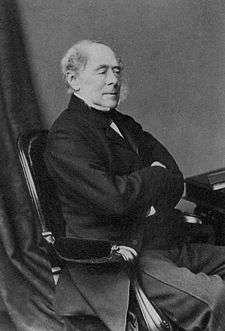
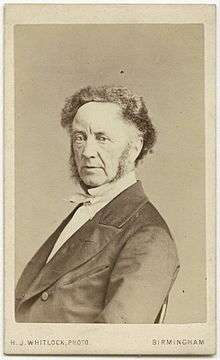











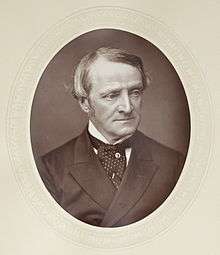
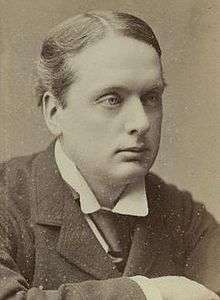











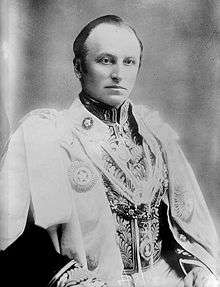










_Vane-Tempest-Stewart%2C_7th_Marquess_of_Londonderry.jpg)












